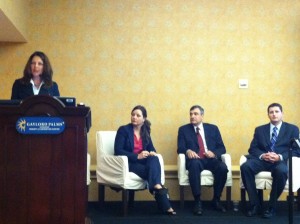
SAS Executive Lead for Customer Intelligence Lori Bieda moderated this panel and introduced the concept of Marketing Optimization as the "Holy Grail" of marketing for the power it holds to enable marketing to fulfill its mandate as driving profitable growth for organizations. Joining her in this session was Stephan Chase, VP of Customer Knowledge at Marriott International and Adam Burgess, SVP of Marketing Strategies at Bank of America.
Marriott's Stephan Chase began by sharing how the implementation of optimization is relatively new to marketing at Marriott, and that they've seen some remarkable results even at a very early stage of implementation. He considers optimization as the destiny of marketing, where most successful companies will see marketing as a demand creation center that manages to best outcomes.
A very enthusastic proponent of predictive Analytics, Stephan described optimization as an analytical discipline that is inherently outcome-oriented. He described how optimization means you need to have a very well defined objective and have the data be available, and be willing to engage in experimentation. While reporting focuses on what happened, and predictive modeling focuses on where we're going, optimization asks the question: How do I perfect an outcome, based on the levers I have access to and knowing when to pull the levers? You can't do it without starting with an outcome in mind.
He described Optimization's deep roots in logistical problem solving, solved by addressing mathematics to achieve the best outcomes. Why marketing is relatively late to the optimization party? He believes there are four reasons - first, historically you could not easily connect cause and effect in marketing, especially before the advent of digital media. Second, you need to have easy data availability, which again has not been easily available before digital media. Third, once digital media made measurement and tracking more feasible, then scale became an issue because suddenly there was a torrent of data. And finally, with all that backdrop, marketing historically developed a culture that's not conducive to measurement. How quickly that has changed!
Adam Burgess, Senior Vice President at Bank of America described how their card area has used marketing optimization for quite some time. The banking leader's operating environment naturally makes their customer relationships very complex and spread across multiple business units, so challenge number one was to get all the data in one place. Also, it's not just about marketing anymore - it's more about interaction management, which means they are also considering the possibility that there are times the customers may not be ready for the next offer but needs an interaction with the bank.
Other challenges Adam described related to how to get the data analyzed meaningfully and then communicated out to the places in the organization that needed it. In their environment, meaningful analysis and modeling account for fixed constraints, such as legal and regulatory and discretionary variables, which can be as complex as the makeup of your target market. Since optimization is really only as good as your imputs, the more granularity you can get all the way down to the individual customer, the better. It means that good optimization is a blend of the science of the data with the art of modeling. Another interesting point for banking is that optimization turns out to be great for managing credit risk because it can help describe the scenarios that deliver results that fall within acceptable bounds of credit risk. Perhaps that's a whole other dimension of customer analytics we don't usually address in this blog, and it's certainly an important one.
The latter part of the session had Lori Bieda leading a discussion about marketing optimization that touched on some important points:
- Process changes can be as important as the software itself in realizing the full potential of the solution. At early stages, proof of concept to gain wide internal acceptance is certainly achievable, but depends on access to data and the clear definition of the desired end outcome.
- Optimization works very well, yet there is always room for improvement. In the short term, it may come from process improvements that help the organization catch up with the capabilities of the solution.
- Real-time decisioning is increasingly becoming an imperative due to marketplace expectations, and as data sets grow into "big data" issues, high performance analytics may show the way to continued value creation.
- For our panelists, optimization has not meant a need to bring in an army of PhD programmers in spite of the great potential of the solution.
In today's market, companies have many ways to interact with customers across multiple channels, and the complexity of managing direct-to-consumer campaigns has exploded with the proliferation of customer touch points. Seeing this session being standing room-only confirms that all marketers today need ways to get the best results with limited resources. Marketing optimization is a great way to achieve those outcomes.
